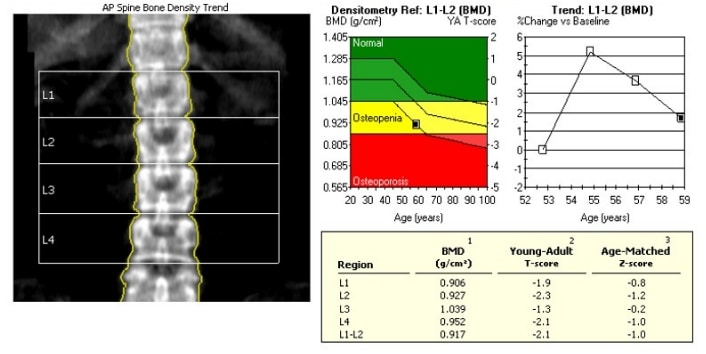

Set up your initial consultation with Dr Burdorf. The only way to know how your body is functioning and what nutrients it is lacking is thru diagnostic testing. Years of eating sub-optimal foods, engaging in inadequate exercise, poor lifestyle habits and living in a polluted environment leads to the gradual development of disease.

Make an Appointment – A comprehensive diagnostic health analysis will help determine any underlying causes or dysfunctions contributing to your low bone density.Calcium/Magnesium/Vitamin D/Vitamin K – All these are essential for strong bones, however the only way to know how much you should take and what other factors may be blocking absorption is thru diagnostic testing.Exercise – Resistance training is essential for strong bones.These factors may include low calcium, low vitamin D, diabetes, depression, caffeine, high salt intake, Hemocchromatosis, medications, alcohol, lack of exercise, Celiac’s disease, lead exposure, smoking, aluminum, IBS, cadmium exposure. A SD below -1.5 could indicate that outside factors are contributing to bone loss. Z-score – Your Z-score compares your bone density to that of someone your age, weight, sex and ethnic origin. A T-score between –1 and –2.5 is considered osteopenia, below normal and may be a sign of coming osteoporosis, and less than –2.5 means osteoporosis. The more SD’s below 0 (indicated as negative numbers) the lower your bone mineral density and the higher your risk of fracture.Ī T-score greater than –1 is considered normal. This is measured in the number of units that your bone density is above or below the optimal bone density. T-score – The T-score is your bone density compared to that of a healthy 30 year old adult of your sex. Your bone density test results are reported in two numbers: T-score and Z-score. Confirm a diagnosis of osteoporosis if you’ve experienced broken bones.Determine your risk of broken bones (fractures).Identify decreases in bone density before you break a bone.The higher your bone mineral content, the denser (stronger) your bones. Your score can help you access your risk of developing a bone fracture as you. This bone density test uses X-rays to measure how many grams of calcium and other bone minerals are packed into a segment of bone. Having a bone density test is the only way to definitively diagnose osteoporosis. Now what do the results mean, and what can you do about them?ĭEXA stands for: Dual Energy X-ray Absorptiometry. As of 2006, the cost of a DEXA scan typically ranges from about $125-$350.You’ve had a bone density test. Private insurance companies vary in their coverage of DEXA scans, and many will cover screening DEXA scans provided that the patient has several osteoporosis risk factors. Medicare may cover follow-up tests every 2 years for certain individuals. Men who have significant risk factors for osteoporosis.Women less than 65 who have significant risk factors for osteoporosis.Medicare usually covers the cost of a DEXA scan to screen for bone density for the following groups of individuals: Given the criticality of early diagnosis and prevention of osteoporosis to avoid a fracture, patients who believe they are at risk for osteoporosis are encouraged to proactively bring up the topic of bone density testing to discuss with their treating physician. Patients are advised to decide with their physician whether or not to have a DEXA bone density test. While bone mass density testing involves a low level of radiation exposure, most medical professionals agree this risk is low (e.g., just a fraction of the exposure in a chest X-ray) compared with the benefits of identifying osteoporosis before a fracture occurs. This particular bone density test is the only one that can be used to diagnose osteoporosis and track bone density changes over time. The DEXA scan results will indicate whether a person has normal bone density, low bone mass, or osteoporosis. The test is performed by passing low energy X-rays through a bone, most often of the lower spine and hips. The established standard for measuring bone density is the dual energy X-ray absorption scan (termed a DEXA scan or DXA scan). Hyperparathyroidism (over-active parathyroid gland).At menopause, if undecided about hormone replacement therapy.Postmenopausal women under age 65 who have multiple risk factors.Preventive Service Task Force, a bone density test is recommended in the following situations: The test measures bone mass, usually in the hip and lumbar spine, quickly and painlessly.Īccording to the National Osteoporosis Foundation and the U.S. A bone density test (also termed "bone mineral density test" or "BMD test") is the gold standard diagnostic procedure used to detect osteoporosis. After determining a patient’s risk factors, the second step in preventing osteoporosis and associated spine fractures is to get an assessment of bone mass.


 0 kommentar(er)
0 kommentar(er)
